Page 60 of 354
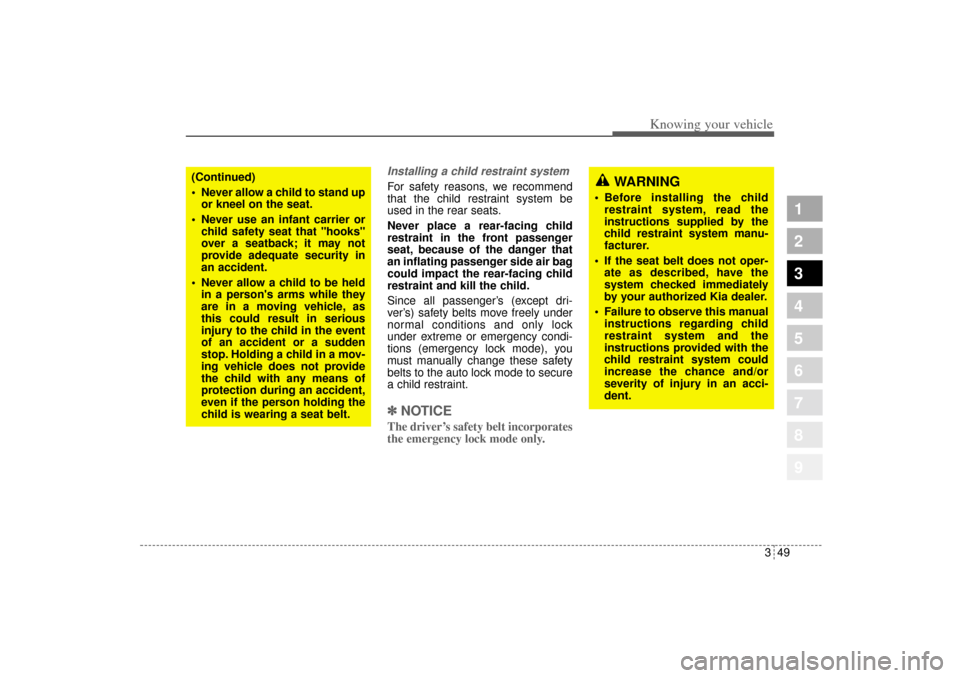
349
Knowing your vehicle
1
2
3
4
5
6
7
8
9
WARNING
Before installing the child
restraint system, read the
instructions supplied by the
child restraint system manu-
facturer.
If the seat belt does not oper-
ate as described, have the
system checked immediately
by your authorized Kia dealer.
Failure to observe this manual
instructions regarding child
restraint system and the
instructions provided with the
child restraint system could
increase the chance and/or
severity of injury in an acci-
dent.
Installing a child restraint system For safety reasons, we recommend
that the child restraint system be
used in the rear seats.
Never place a rear-facing child
restraint in the front passenger
seat, because of the danger that
an inflating passenger side air bag
could impact the rear-facing child
restraint and kill the child.
Since all passenger’s (except dri-
ver’s) safety belts move freely under
normal conditions and only lock
under extreme or emergency condi-
tions (emergency lock mode), you
must manually change these safety
belts to the auto lock mode to secure
a child restraint.✽ ✽
NOTICEThe driver’s safety belt incorporates
the emergency lock mode only.
(Continued)
Never allow a child to stand up
or kneel on the seat.
Never use an infant carrier or
child safety seat that "hooks"
over a seatback; it may not
provide adequate security in
an accident.
Never allow a child to be held
in a person's arms while they
are in a moving vehicle, as
this could result in serious
injury to the child in the event
of an accident or a sudden
stop. Holding a child in a mov-
ing vehicle does not provide
the child with any means of
protection during an accident,
even if the person holding the
child is wearing a seat belt.
KM CAN (ENG) 3 (~57).qxd 9/13/2004 4:49 PM Page 49
Page 61 of 354
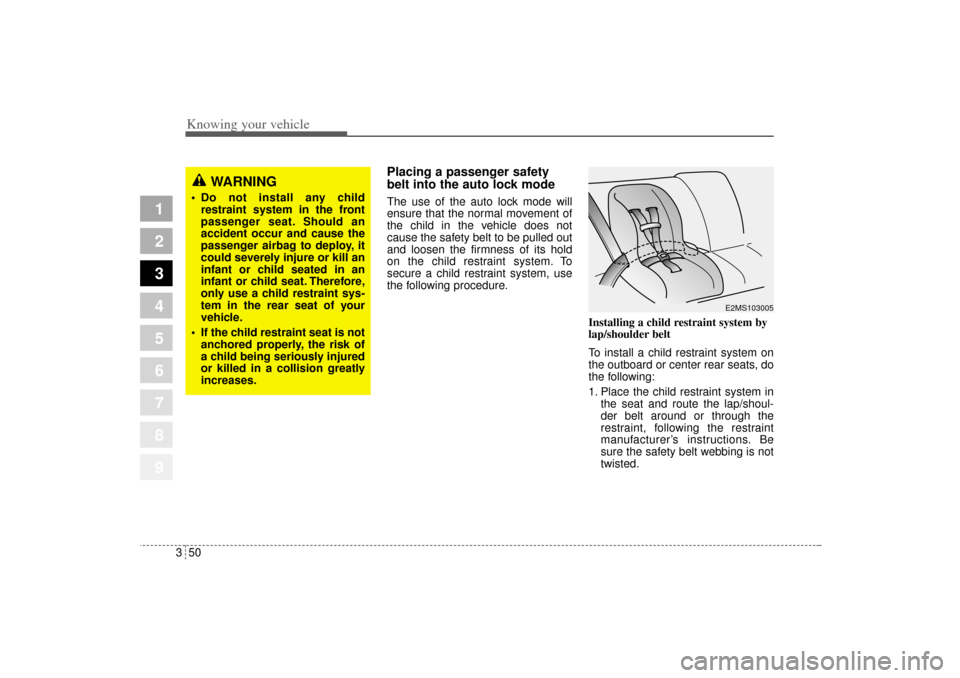
Knowing your vehicle50 3
1
2
3
4
5
6
7
8
9
Placing a passenger safety
belt into the auto lock modeThe use of the auto lock mode will
ensure that the normal movement of
the child in the vehicle does not
cause the safety belt to be pulled out
and loosen the firmness of its hold
on the child restraint system. To
secure a child restraint system, use
the following procedure.
Installing a child restraint system by
lap/shoulder belt
To install a child restraint system on
the outboard or center rear seats, do
the following:
1. Place the child restraint system in
the seat and route the lap/shoul-
der belt around or through the
restraint, following the restraint
manufacturer’s instructions. Be
sure the safety belt webbing is not
twisted.
WARNING
Do not install any child
restraint system in the front
passenger seat. Should an
accident occur and cause the
passenger airbag to deploy, it
could severely injure or kill an
infant or child seated in an
infant or child seat. Therefore,
only use a child restraint sys-
tem in the rear seat of your
vehicle.
If the child restraint seat is not
anchored properly, the risk of
a child being seriously injured
or killed in a collision greatly
increases.
E2MS103005
KM CAN (ENG) 3 (~57).qxd 9/13/2004 4:49 PM Page 50
Page 64 of 354
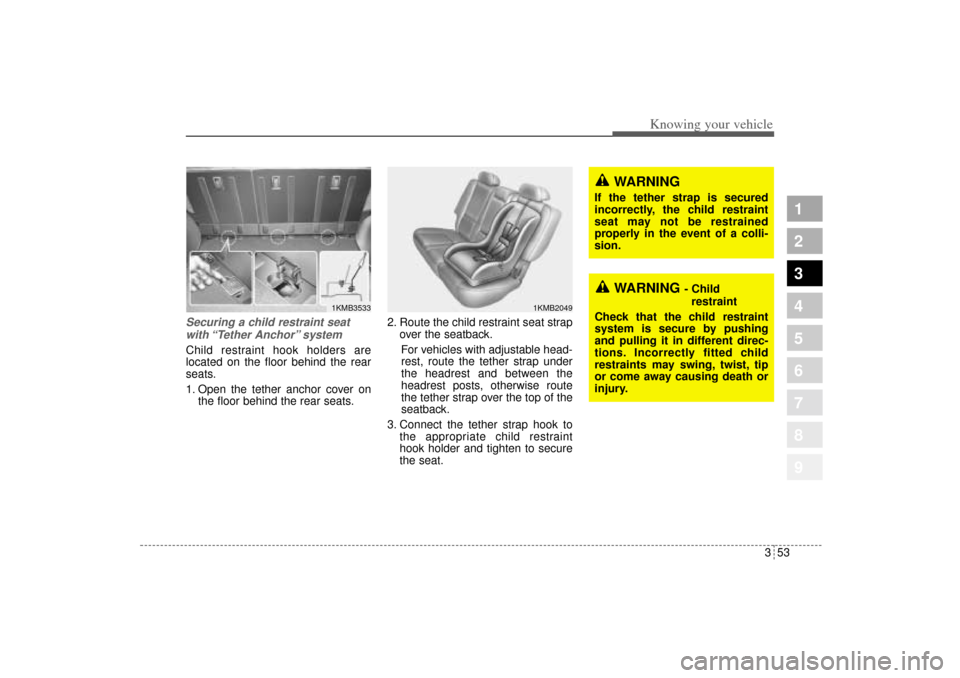
353
Knowing your vehicle
1
2
3
4
5
6
7
8
9
Securing a child restraint seat
with “Tether Anchor” system Child restraint hook holders are
located on the floor behind the rear
seats.
1. Open the tether anchor cover on
the floor behind the rear seats.2. Route the child restraint seat strap
over the seatback.
For vehicles with adjustable head-
rest, route the tether strap under
the headrest and between the
headrest posts, otherwise route
the tether strap over the top of the
seatback.
3. Connect the tether strap hook to
the appropriate child restraint
hook holder and tighten to secure
the seat.
1KMB2049
1KMB3533
WARNING
If the tether strap is secured
incorrectly, the child restraint
seat may not be restrained
properly in the event of a colli-
sion.
WARNING
- Child
restraint
Check that the child restraint
system is secure by pushing
and pulling it in different direc-
tions. Incorrectly fitted child
restraints may swing, twist, tip
or come away causing death or
injury.
KM CAN (ENG) 3 (~57).qxd 9/13/2004 4:49 PM Page 53
Page 65 of 354
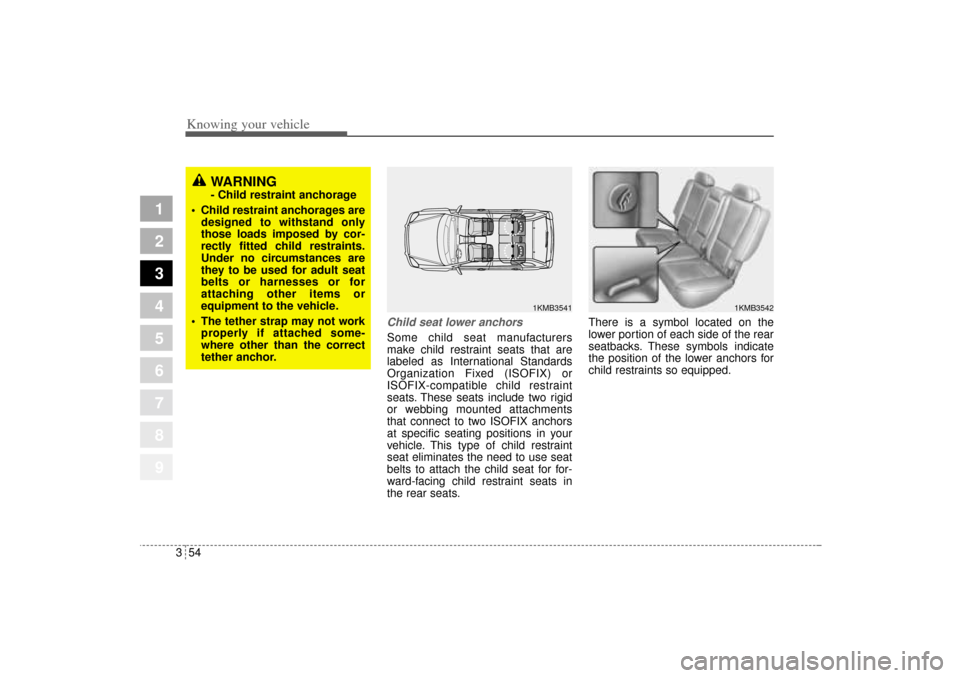
Knowing your vehicle54 3
1
2
3
4
5
6
7
8
9
Child seat lower anchorsSome child seat manufacturers
make child restraint seats that are
labeled as International Standards
Organization Fixed (ISOFIX) or
ISOFIX-compatible child restraint
seats. These seats include two rigid
or webbing mounted attachments
that connect to two ISOFIX anchors
at specific seating positions in your
vehicle. This type of child restraint
seat eliminates the need to use seat
belts to attach the child seat for for-
ward-facing child restraint seats in
the rear seats.There is a symbol located on the
lower portion of each side of the rear
seatbacks. These symbols indicate
the position of the lower anchors for
child restraints so equipped.
1KMB3541
1KMB3542
WARNING - Child restraint anchorage
Child restraint anchorages are
designed to withstand only
those loads imposed by cor-
rectly fitted child restraints.
Under no circumstances are
they to be used for adult seat
belts or harnesses or for
attaching other items or
equipment to the vehicle.
The tether strap may not work
properly if attached some-
where other than the correct
tether anchor.
KM CAN (ENG) 3 (~57).qxd 9/13/2004 4:50 PM Page 54
Page 66 of 354
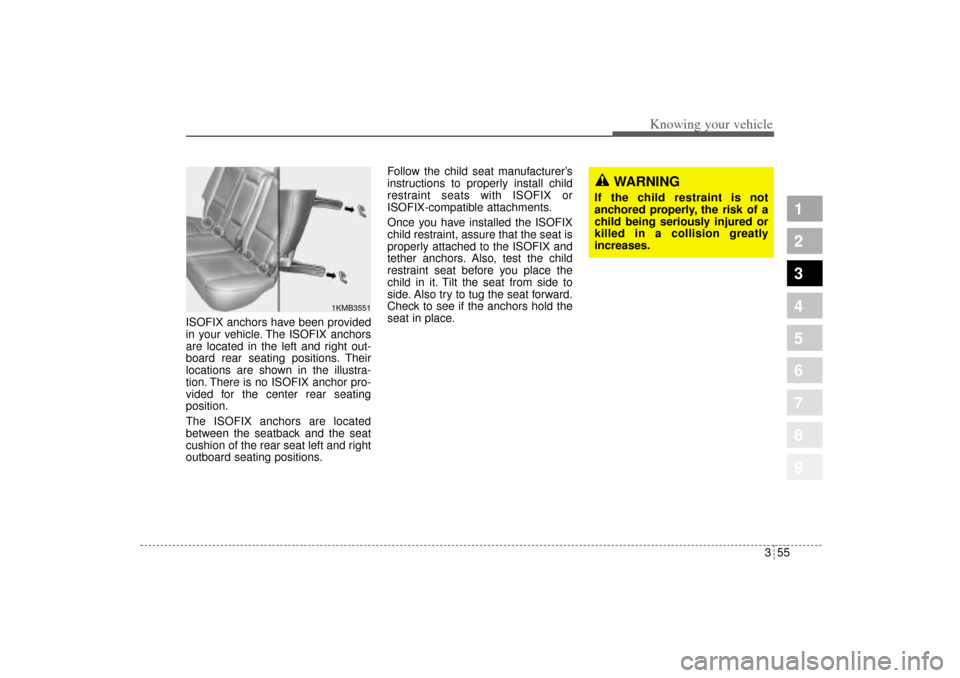
355
Knowing your vehicle
1
2
3
4
5
6
7
8
9
ISOFIX anchors have been provided
in your vehicle. The ISOFIX anchors
are located in the left and right out-
board rear seating positions. Their
locations are shown in the illustra-
tion. There is no ISOFIX anchor pro-
vided for the center rear seating
position.
The ISOFIX anchors are located
between the seatback and the seat
cushion of the rear seat left and right
outboard seating positions.Follow the child seat manufacturer’s
instructions to properly install child
restraint seats with ISOFIX or
ISOFIX-compatible attachments.
Once you have installed the ISOFIX
child restraint, assure that the seat is
properly attached to the ISOFIX and
tether anchors. Also, test the child
restraint seat before you place the
child in it. Tilt the seat from side to
side. Also try to tug the seat forward.
Check to see if the anchors hold the
seat in place.
1KMB3551
WARNING
If the child restraint is not
anchored properly, the risk of a
child being seriously injured or
killed in a collision greatly
increases.
KM CAN (ENG) 3 (~57).qxd 9/13/2004 4:50 PM Page 55
Page 67 of 354
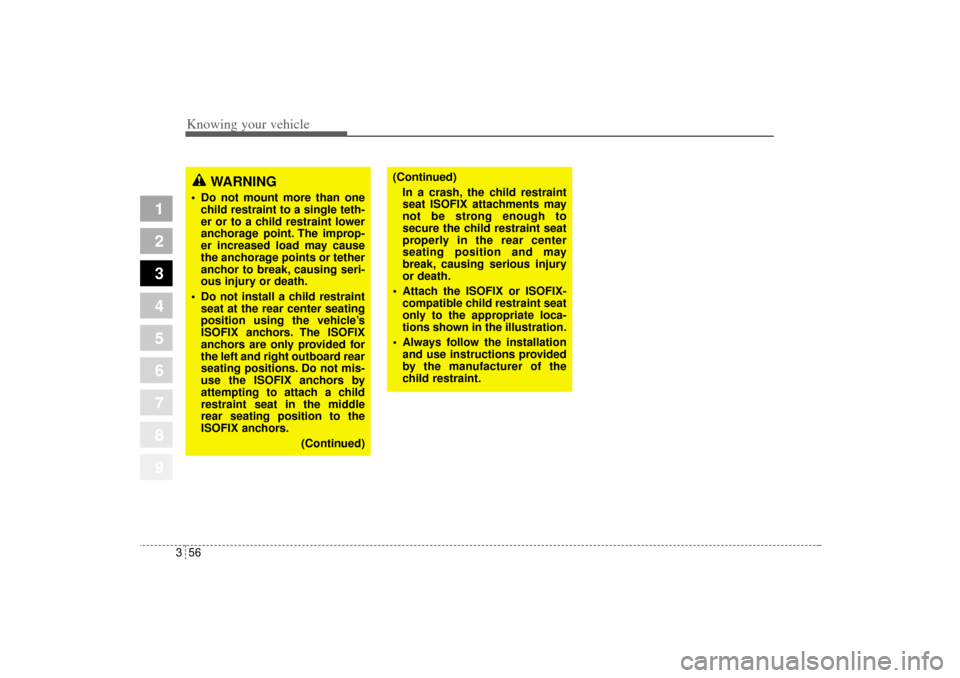
Knowing your vehicle56 3
1
2
3
4
5
6
7
8
9
(Continued)
In a crash, the child restraint
seat ISOFIX attachments may
not be strong enough to
secure the child restraint seat
properly in the rear center
seating position and may
break, causing serious injury
or death.
Attach the ISOFIX or ISOFIX-
compatible child restraint seat
only to the appropriate loca-
tions shown in the illustration.
Always follow the installation
and use instructions provided
by the manufacturer of the
child restraint.
WARNING
Do not mount more than one
child restraint to a single teth-
er or to a child restraint lower
anchorage point. The improp-
er increased load may cause
the anchorage points or tether
anchor to break, causing seri-
ous injury or death.
Do not install a child restraint
seat at the rear center seating
position using the vehicle’s
ISOFIX anchors. The ISOFIX
anchors are only provided for
the left and right outboard rear
seating positions. Do not mis-
use the ISOFIX anchors by
attempting to attach a child
restraint seat in the middle
rear seating position to the
ISOFIX anchors.
(Continued)
KM CAN (ENG) 3 (~57).qxd 9/13/2004 4:50 PM Page 56
Page 74 of 354
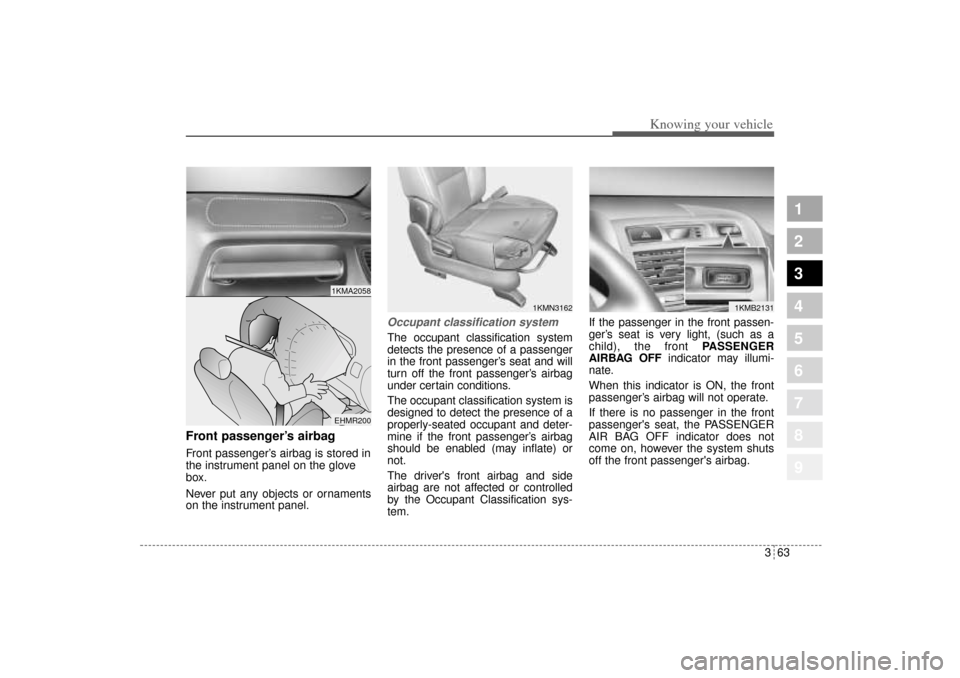
363
1
2
3
4
5
6
7
8
9
Knowing your vehicle
Front passenger’s airbagFront passenger’s airbag is stored in
the instrument panel on the glove
box.
Never put any objects or ornaments
on the instrument panel.
Occupant classification systemThe occupant classification system
detects the presence of a passenger
in the front passenger’s seat and will
turn off the front passenger’s airbag
under certain conditions.
The occupant classification system is
designed to detect the presence of a
properly-seated occupant and deter-
mine if the front passenger’s airbag
should be enabled (may inflate) or
not.
The driver's front airbag and side
airbag are not affected or controlled
by the Occupant Classification sys-
tem.If the passenger in the front passen-
ger’s seat is very light, (such as a
child), the front PASSENGER
AIRBAG OFFindicator may illumi-
nate.
When this indicator is ON, the front
passenger’s airbag will not operate.
If there is no passenger in the front
passenger's seat, the PASSENGER
AIR BAG OFF indicator does not
come on, however the system shuts
off the front passenger's airbag.
1KMB2131
1KMN3162
1KMA2058EHMR200
KM CAN (ENG) 3 (~112).qxd 9/13/2004 4:50 PM Page 63
Page 75 of 354
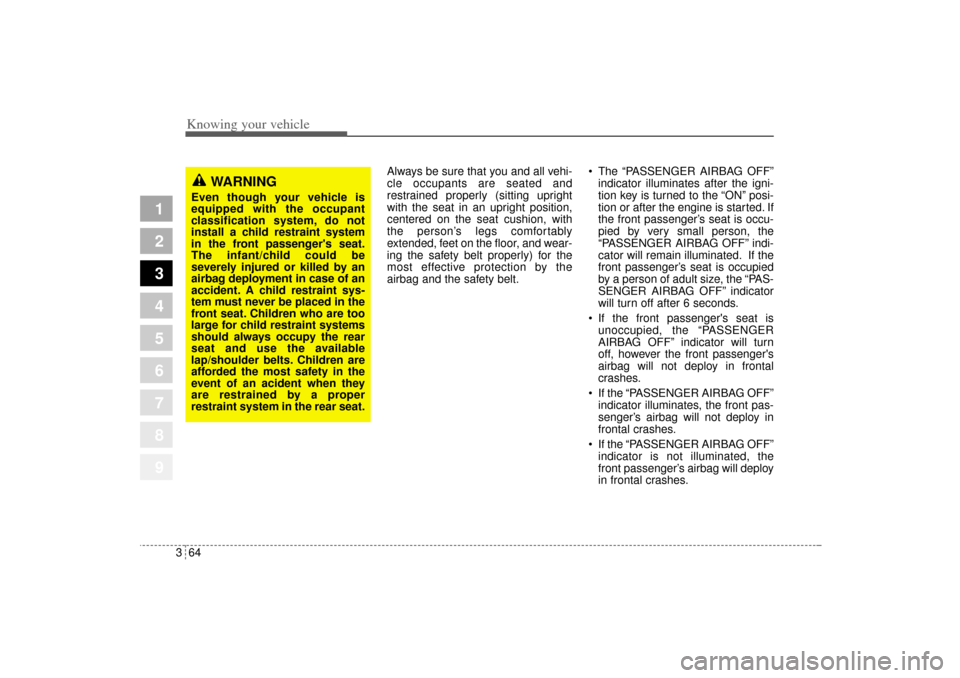
Knowing your vehicle64 3
1
2
3
4
5
6
7
8
9
Always be sure that you and all vehi-
cle occupants are seated and
restrained properly (sitting upright
with the seat in an upright position,
centered on the seat cushion, with
the person’s legs comfortably
extended, feet on the floor, and wear-
ing the safety belt properly) for the
most effective protection by the
airbag and the safety belt. The “PASSENGER AIRBAG OFF”
indicator illuminates after the igni-
tion key is turned to the “ON” posi-
tion or after the engine is started. If
the front passenger’s seat is occu-
pied by very small person, the
“PASSENGER AIRBAG OFF” indi-
cator will remain illuminated. If the
front passenger’s seat is occupied
by a person of adult size, the “PAS-
SENGER AIRBAG OFF” indicator
will turn off after 6 seconds.
If the front passenger's seat is
unoccupied, the “PASSENGER
AIRBAG OFF” indicator will turn
off, however the front passenger's
airbag will not deploy in frontal
crashes.
If the “PASSENGER AIRBAG OFF”
indicator illuminates, the front pas-
senger’s airbag will not deploy in
frontal crashes.
If the “PASSENGER AIRBAG OFF”
indicator is not illuminated, the
front passenger’s airbag will deploy
in frontal crashes.
WARNING
Even though your vehicle is
equipped with the occupant
classification system, do not
install a child restraint system
in the front passenger's seat.
The infant/child could be
severely injured or killed by an
airbag deployment in case of an
accident. A child restraint sys-
tem must never be placed in the
front seat. Children who are too
large for child restraint systems
should always occupy the rear
seat and use the available
lap/shoulder belts. Children are
afforded the most safety in the
event of an acident when they
are restrained by a proper
restraint system in the rear seat.
KM CAN (ENG) 3 (~112).qxd 9/13/2004 4:50 PM Page 64